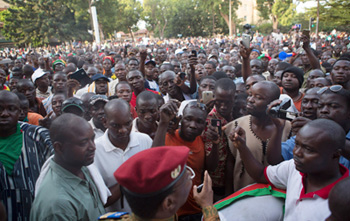

Vol. 78/No. 41 November 17, 2014

|
| Reuters/Joe Penney |
| Protesters outside military headquarters in Ouagadougou, Burkina Faso, Oct. 30, during mass outpouring across country that forced President Blaise Compaoré to resign next day. |
BY MAGGIE TROWE
Popular demonstrations of hundreds of thousands in the West African country of Burkina Faso forced President Blaise Compaoré out of power Oct. 31. The mobilization was sparked by the tyrant’s move to amend the constitution to allow him to remain in office for a fifth term. Actions in solidarity with the protests took place in nearby Ghana, Ivory Coast and other African countries, as well as throughout Europe and North America, including in Montreal, Paris, New York and Berlin.
Compaoré had ruled the landlocked country of 17 million since he usurped power in 1987 in a coup that overturned a popular democratic revolution with the killing of its central leader, Thomas Sankara, and other revolutionary cadre.
Burkina Faso is among the poorest countries in the world. Life expectancy is 56 years, the infant mortality rate is the ninth highest in the world and some 90 percent of the population is engaged in subsistence agriculture. Compaoré’s government reversed social projects aimed at combating this legacy and prioritized efforts to attract foreign capitalist investment in gold mining and cotton. Several years of falling prices of the two commodities have resulted in economic contraction and deteriorating social conditions for the majority.
The revolt against Compaoré’s rule was prepared in the days before the scheduled Oct. 30 vote on the amendment. “We helped organize caravans of cars and motorbikes that stopped in markets and gas stations around the country urging people to come out,” Serge Bambara, a rap singer known as “Smokey” and a leader of the group Balai Citoyen (the Civic Broom), said in a Nov. 4 phone interview from Ouagadougou, the country’s capital. “People set up barricades on all the roads and in all the cities. We gathered near the National Assembly the night of Oct. 29 and stayed there.”
Demonstrations grew and continued Oct. 30 and 31, as more and more gained confidence to come into the street actions organized by several opposition parties, unions and other groups.
Various wings of the officer corps and sections of the country’s propertied ruling class have scrambled to cobble together a new government, vying with each other for power as they seek to close down space opened by popular mobilizations for toilers to organize and fight.
After Compaoré’s departure, Gen. Honoré Traoré, chief of staff of the army, declared Oct. 31 he would be in charge until elections could take place within a year. The next day, in face of new protests against Traoré, a group of junior officers led by Lt. Col. Yacouba Isaac Zida took over.
Concerned above all with bringing an end to the protest movement, Washington, Paris and allied African governments under the rubric of the African Union called for the military to hand over power to civilian authorities.
On Nov. 2 some 1,000 protesters in Ouagadougou led by opposition parties calling for civilian rule were dispersed by soldiers.
Demonstrations have since tapered off for the time being.
Renewed interest in 1983 revolution
The overthrow of Compaoré has renewed discussion and interest in the political legacy of Thomas Sankara and the advances of the democratic popular revolution he led. The 1983-87 revolution nationalized the land to guarantee to rural agricultural producers the fruit of their labor; it launched a mass tree-planting and irrigation project to stop the advance of the desert; it organized massive literacy and immunization campaigns and for the first time made basic health care available to millions. Women were drawn in large numbers into the social transformation, which included a fight to combat women’s oppression.
The Burkinabe Revolution under Sankara’s leadership identified with the revolutions in Cuba and Nicaragua and championed the struggles of peasants, workers and oppressed peoples in the region, from the fight against apartheid in South Africa to the national struggles of the Palestinians in the Middle East and the Saharawi people in northwest Africa. It sought to build a world movement among semicolonial nations for cancellation of the debt owed to imperialist centers of finance.
Campaoré was a close ally of Washington and Paris, both of which established military bases in the country. Over the last two years the U.S. government allocated more than $15 million in “counterterrorism” funding to boost the Campaoré regime’s military capacity.
Demonstrators dubbed their protest the “Black Spring,” a term inspired by the “Arab Spring,” which began with the 2011 uprisings in Tunisia and Egypt that overthrow hated dictators. The protests have unnerved exploiting classes throughout the region. In the Democratic Republic of the Congo, for example, prison officials in the capital removed televisions from inmates’ cells to prevent them from watching the news from the neighboring country, reported Agence France-Presse.
Capitalist media coverage in the U.S. and Europe have painted a picture of “chaos,” with emphasis on burned buildings and looting and the unfortunate loss of a stable ally in Compaoré. “He remained close to the French during his presidency and came to be seen as a pro-Western leader and ally in the battle against Islamist militancy in the region,” the New York Times wrote Oct. 31.
“I was not surprised by the uprising,” Marc Kabore, 35, a dish washer who recently moved to New York from Burkina Faso, told the Militant. “People were fed up with the government, especially the repression and lack of democracy.”
Related articles:
Thomas Sankara: Struggles of women deepen revolution
Front page (for this issue) |
Home |
Text-version home